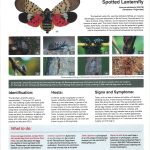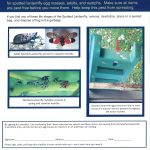Spotted Lanternfly Control
The Spotted Lanternfly, (Lycorma delicatula [White]), an invasive planthopper, was originally discovered in Berks County, Pennsylvania, and has since spread to multiple counties and other states. It is native to China, India, Vietnam, and introduced to Korea where it has become a major pest. This insect has the potential to greatly impact the grape, hops, and logging industries. Early detection is vital for the protection of Pennsylvania businesses and agriculture.
Identification:
The Spotted Lanternfly adult is approximately 1″ long and 1/2″ wide at rest. The forewing is grey with black spots and the wings tips are reticulated black blocks outlined in grey. The hind wings have contrasting patches of red and black with a white band. The legs and head are black; the abdomen is yellow with broad black bands. Immature stages are black with white spots, and develop red patches as they grow.
Signs & Symptoms:
Trees such as tree of heaven and willow will develop weeping wounds. These wounds will leave a greyish or black trail along the trunk. This sap will attract other insects to feed, notably wasps and ants. In late fall, adults will lay egg masses on host trees and nearby smooth surfaces like stone, outdoor furniture, vehicles, and structures. Newly laid egg masses have a grey mud-like covering which can take on a dry cracked appearance over time. Old egg masses appear as rows of 30-50 brownish seed-like deposits in 4-7 columns on the trunk, roughly an inch long.
Illustrating the seriousness of the issue, on February 8, 2018, the U.S. Secretary of Agriculture announced $17.5 million in emergency funding to counter this invasive pest.
Read more about the Secretary of Agriculture’s announcement
Resources:
The Penn State Extension, including what to do if you find the Spotted Lanternfly on your property.
Pennsylvania Department of Agriculture Spotted Lanternfly Program
Click on the thumbnails below to view the program handouts.


